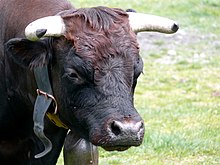
The Simmental or Swiss Fleckvieh is a Swiss breed of dual-purpose cattle. It is named after the Simmental – the valley of the Simme river – in the Bernese Oberland, in the canton of Bern in Switzerland. It is reddish in colour with white markings, and is raised for both milk and meat.
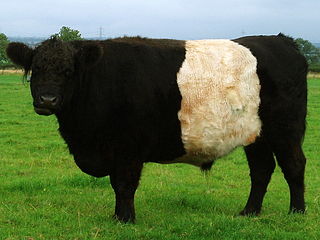
The Belted Galloway is a traditional Scottish breed of beef cattle. It derives from the Galloway cattle of the Galloway region of south-western Scotland, and was established as a separate breed in 1921. It is adapted to living on the poor upland pastures and windswept moorlands of the region. The exact origin of the breed is unclear, although the white belt for which they are named – and which distinguishes the breed from the native black Galloway cattle – is often surmised to be the result of cross-breeding with the similarly-coloured Dutch Lakenvelder breed.

Combat de Reines or Swiss Cow fighting;, is a traditional event held mostly in the Swiss canton of Valais, in which a cow fights another cow . Each year, the Swiss canton of Valais hosts a series of cow fights known as combats de reines, which began in the 1920s and has drawn as many as 50,000 spectators in a year. The winner is called La Reine des Reines and increases dramatically in value. At the end of the year, a grand final is held in Aproz, where the six best from seven districts do battle in six weight categories.

The Herens is a breed of cattle named after the Val d'Hérens region of Switzerland. These small, horned alpine cattle are coloured black, brown or dark red, often with a lighter stripe along the spine. The cows are used in organised cow fights.

Évolène cattle are an old breed of dairy cattle from the Valais canton of Switzerland. It is an endangered cattle breed.

The Tux-Zillertal, German: Tux-Zillertaler, is an endangered Austrian breed of domestic cattle. It was created in 1982 when two similar Alpine breeds, the Tux and the Zillertal, were merged. The two names derive from those of the municipality of Tux in the Tuxertal, and of the neighbouring Zillertal, both in the Tirol region of Austria. The Tux-Zillertal may derive from the Swiss Hérens breed. Like the Hérens, it was long selected for the fighting ability of the cows, at the expense of productive characteristics.

The Montbéliarde is a breed of red pied dairy cattle from the area of Montbéliard, in the département of Doubs, in the Bourgogne-Franche-Comté region of eastern France. It is used mainly for dairying and particularly for cheesemaking.
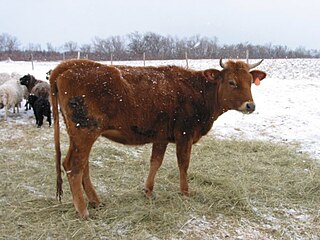
Canadienne cattle, also known as Black Canadienne, French Canadienne, and Black Jersey, are the only breed of dairy cattle developed in Canada. They originated in the 16th century, when French settlers brought cattle over for foundation stock to settle Canada. The Canadienne were the most common breed of domestic cattle in Canada until the late 19th century, when other breeds began to displace them. Today, the Hereford and Holstein have become the most common types of cattle in Canada. The Canadienne, though still found on farms and ranches across the nation, is now comparatively rare except in certain areas of the province of Quebec. Efforts by an active breed society and the Quebec government have been made in recent years to preserve the breed from extinction.
The Burlina is a breed of cattle from the mountainous areas of the Veneto region of north-east Italy. It is distributed mainly in the provinces of Treviso, Verona and Vicenza. It is a dual-purpose breed, but is raised principally for milk production. It has been suggested that it may be related to the similar Bretonne Pie Noir breed of small pied dairy cattle in Brittany.
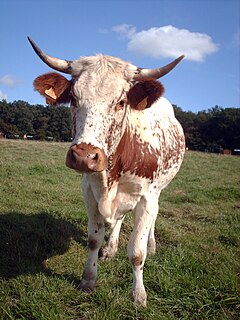
The Ferrandaise is an endangered French breed of domestic cattle from the département of Puy-de-Dôme, in the Massif Central mountains of Auvergne, in central France. It is named for the city and commune of Clermont-Ferrand, the capital of Puy-de-Dôme.

The Podolica is a breed of domestic cattle from southern Italy. It belongs to the Podolic group of grey cattle. It is raised in the regions of Abruzzo, Basilicata, Calabria, Campania, Molise and Puglia. It was formerly distributed throughout most of mainland Italy and as far as Istria, now part of Croatia, and where it is now regarded as a separate breed, Istrian cattle. The Podolica was in the past bred principally as a draught animal; with the mechanisation of agriculture following the Second World War demand for draught oxen disappeared, and the Podolica is now raised for meat and, to a lesser extent, for milk.

The Rendena is a breed of cattle from the Trentino, in north-eastern Italy, now raised principally in the provinces of Padova, Trento, Verona and Vicenza. It is particularly suited to transhumant management; almost all the stock in the Trentino spends the summer months on the mountain pastures of the Val Rendena, and more than half of that in the Veneto summers on the Altopiano di Asiago.
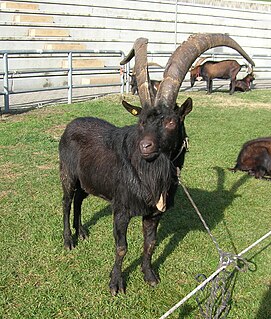
The Valdostana is an indigenous breed of domestic goat from the autonomous region of Aosta Valley in north-western Italy, from which it takes its name.

The Battle of the Queens is an annual Cow fighting tournament that takes place in the Aosta Valley.

The Valdostana Pezzata Rossa is an Italian breed of cattle from Valle d'Aosta region in north-western Italy. It is red-pied, usually with white legs, stomach and face. It is one of three regional breeds in the area, the others being the Valdostana Castana and the Valdostana Pezzata Nera. Like them, it derives from inter-breeding of various local breeds and types of cattle. The most important of these were Swiss Simmental cattle, which came into the Valle d'Aosta over the Great St. Bernard Pass. The Valdostana Pezzata Rossa is a dual-purpose breed, raised mainly for milk, but also for meat. Management is normally transhumant: the cattle are stabled only in winter, and spend the summer months on the mountain pastures of the Alps.
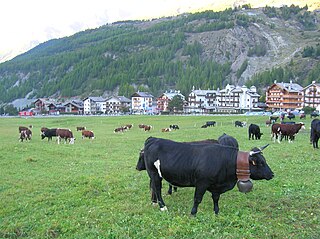
The Valdostana Pezzata Nera is an Italian breed of cattle from Valle d'Aosta region in north-western Italy. It is black-pied, with short horns. It is one of three regional breeds in the area, the others being the Valdostana Castana and the Valdostana Pezzata Rossa. Like them, it derives from inter-breeding of various local breeds and types of cattle. It appears to have been most influenced by the Swiss Fribourgeoise and Hérens breeds, which came into the Valle d'Aosta over the Great St. Bernard Pass. The Valdostana Pezzata Nera is a dual-purpose breed, raised mainly for milk, but also for meat. Management is normally transhumant: the cattle are stabled only in winter, and spend the summer months on the mountain pastures of the Alps.
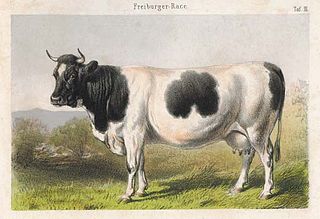
The Fribourgeoise or Freiburger was a Swiss breed of cattle from the Canton of Fribourg in western Switzerland. From about 1966 it was systematically cross-bred with imported Holstein stock. It became effectively extinct with the death of the last pure-bred bull in 1973, and was absorbed into the Swiss Holstein.
The Swiss Holstein is the Swiss variant of the international Holstein-Friesian breed of dairy cattle. It results from systematic cross-breeding, through artificial insemination between 1966 and 1973, of the traditional dual-purpose black-pied Fribourgeoise from the Canton of Fribourg in western Switzerland with Canadian Holstein stock.
